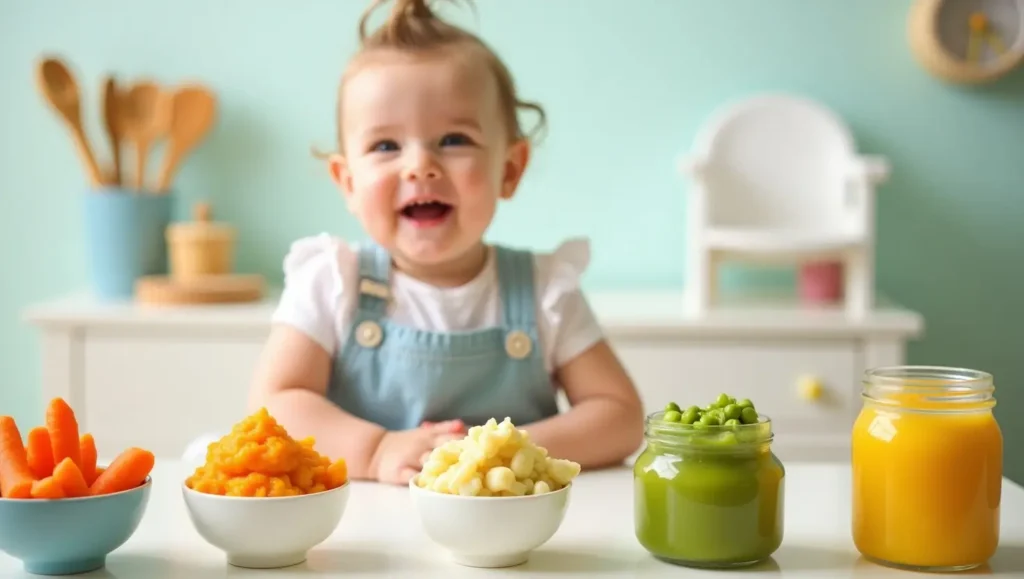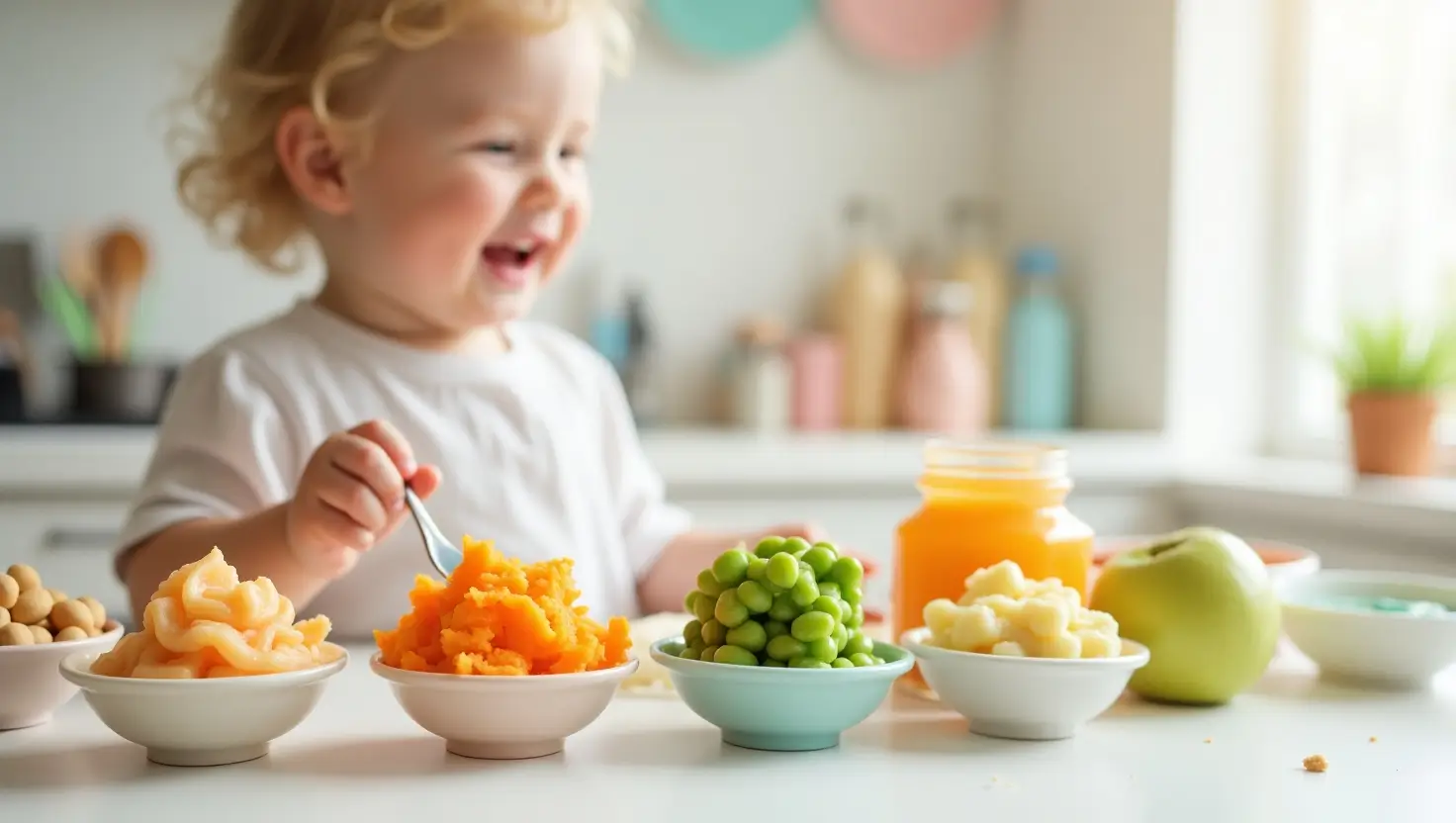Baby Food Recipes
Table of Contents
When introducing solids to your baby, offering nutritious and developmentally appropriate meals is essential. In this comprehensive guide to baby food recipes, we will explore meal ideas from 6 months to 12 months of age.
Why Homemade Baby Food Matters
Homemade baby food gives parents control over the ingredients, ensuring there are no hidden additives, sugars, or preservatives. It’s also more economical and allows the baby to be introduced to a variety of textures and tastes from an early age.
Introducing Solids : The Basics
At around 6 months, most babies are ready to begin eating solids. Signs of readiness include sitting up with support, showing interest in your food, and the ability to swallow soft solids.
To avoid allergic reactions, it’s best to introduce one new food every 3–5 days. Always start with single-ingredient purees and gradually move to combinations as your baby adapts.
Baby Food Recipes for 6–8 Months
This age is about exploring new tastes and textures. Babies still rely on breast milk or formula for most of their nutrition, so food at this stage is more about introduction.
Key Characteristics:
- Smooth purees
- Single-ingredient foods
- Iron-rich options

Examples of Baby Food Recipes 6-8 Months:
- Avocado Puree:
- Scoop out ripe avocado
- Mash or blend with breast milk or formula for desired consistency
- Pear Puree:
- Peel, core, and steam pears
- Blend until smooth
- Butternut Squash Puree:
- Refer to our detailed Butternut Squash Baby Food guide
- Rice Cereal:
- Follow our step-by-step Rice Cereal for Babies article for preparation and benefits
- Carrot and Apple Puree:
- Steam equal parts carrot and apple
- Blend together for a naturally sweet combo
Safety Tips:
- Always test temperature before serving
- Start with 1–2 tablespoons per meal
- Introduce water in small sips
Sample Baby Feeding Schedule (6–8 Months)
| Time of Day | Meal | Notes |
|---|---|---|
| Morning | Breast milk or formula | Add puree after milk if desired |
| Mid-Morning | Avocado puree | Serve 1–2 tablespoons |
| Lunch | Breast milk or formula | |
| Afternoon | Butternut squash puree | Link to recipe above |
| Evening | Rice cereal + apple puree | Smooth consistency |
Baby Food Recipes for 8–10 Months
As babies gain experience with solids, they can handle thicker textures and small food pieces. This phase allows for more diverse recipes.
Key Characteristics:
- Chunkier purees or mashed foods
- Introduction of proteins (chicken, lentils)
- Finger foods (soft fruits, cooked veggies)
Examples:
- Mashed Banana and Yogurt
- Chicken and Sweet Potato Mash
- Lentil and Spinach Puree
- Cottage Cheese and Peas
- Oats with Pear

Pro Tip: Use herbs like cinnamon or thyme in small amounts to add flavor naturally.
Baby Food Recipes for 10–12 Months
Your baby is now closer to toddlerhood and can handle a wider variety of textures, finger foods, and even small pieces of soft-cooked meals you prepare for the rest of the family.
Key Characteristics:
- Minced or chopped foods
- Combo meals with grains, protein, and veggies
- Transitioning from purees to table foods
Examples:
- Mini Meatballs with Veggie Mash
- Scrambled Eggs with Spinach
- Mashed Chickpeas with Olive Oil
- Mini Pasta with Tomato Sauce
- Quinoa and Zucchini Patties
Food Texture Progression by Age
| Age Range | Texture Description | Food Examples |
|---|---|---|
| 6–8 Months | Smooth purees | Avocado, rice cereal, pear |
| 8–10 Months | Mashed/lumpy | Chicken mash, banana yogurt |
| 10–12 Months | Chopped/minced/table foods | Pasta, scrambled eggs, mini patties |
Creating Balanced Meals : Nutritional Focus
A good baby food recipe isn’t just about taste—it must include proper nutrients like iron, calcium, zinc, and healthy fats. Combining grains, proteins, and vegetables ensures your baby gets a full spectrum of nutrition.
Food Groups to Include:
- Proteins: Chicken, lentils, beans
- Carbohydrates: Sweet potatoes, rice, oats
- Fruits and Veggies: Apples, squash, spinach
- Fats: Avocado, olive oil
Baby Food Recipes for 12 Months
By 12 months, your baby likely eats three meals and two snacks daily. This is a time for transitioning to family meals and more independence with feeding.
Key Characteristics:
- Variety of textures and flavors
- Self-feeding encouraged
- Use of small utensils
Examples of Baby Food Recipes 12 Months:
- Vegetable Fried Rice:
- Use soft-cooked vegetables and cooked rice
- Light seasoning and minimal oil
- Mini Pancakes with Fruit:
- Made from whole wheat flour and banana
- Serve with yogurt or soft fruit slices
- Turkey and Veggie Quesadilla:
- Whole grain tortilla, shredded turkey, and cheese
- Grill lightly and cut into small pieces
- Spinach and Cheese Muffins
- Baked Salmon with Sweet Potato Wedges

Encouraging healthy eating habits at this stage sets the tone for your child’s long-term relationship with food.
Storing and Freezing Baby Food
Batch cooking saves time. Use BPA-free containers or silicone trays for freezing purees. Label each container with the date and contents. Frozen baby food typically lasts:
- In the fridge: 2–3 days
- In the freezer: 1–3 months
Allergies and Common Food Sensitivities
Watch for signs like rash, vomiting, or diarrhea when introducing new foods. Common allergens include:
- Dairy
- Eggs
- Peanuts
- Soy
- Wheat
Introduce these carefully and consult with your pediatrician.
Final Thoughts: Making Baby Food Fun
Mealtime is a sensory experience. Let your baby explore textures with their hands, try different tastes, and enjoy the experience. Use colorful bowls, fun utensils, and offer praise to build positive associations.
By following this comprehensive guide on baby food recipes, you’re setting the foundation for a lifetime of healthy eating.

